2021 HYUNDAI TUCSON HYBRID warning light
[x] Cancel search: warning lightPage 576 of 630

09
9-29
Battery capacity label
„„Type A
OTM090063L
„„Type B
OTM090064L
1. MF68L-DIN : The HYUNDAI model
name of battery
2.
12V : The nominal voltage
3.
68Ah (20HR) : The nominal capacity
(in Ampere hour
s)
4.
RC 110min : The nominal capacity (in
Amper
e hours)
5.
600A : The cold-
test current in
amperes by SAE/EN
Battery recharging
By battery charger
Your vehicle has a maintenance-free,
calcium-based battery.
• If the battery becomes discharged
over a short time (because, for
example, the headlamps or interior
lights were left on while the vehicle
was not in use), recharge it by slow
charging (trickle) for 10 hours.
• If the battery gradually discharges
because of high electrical load while
the vehicle is being used, recharge it
at 20-30A for two hours.
WARNING
Always follow these instructions when
recharging your vehicle’s battery to
avoid the risk of SERIOUS INJURY or
DEATH from explosions or acid burns:
• Before performing maintenance or
recharging the battery, turn off all
accessories and stop the engine.
• Keep all flames, sparks, or smoking
materials away from the battery.
• Always work outdoors or in an area
with plenty of ventilation.
• Wear eye protection when checking
the battery during charging.
• The battery must be removed from
the vehicle and placed in a well
ventilated area.
• Watch the battery during charging,
and stop or reduce the charging
rate if the battery cells begin boiling
violently.
Page 588 of 630
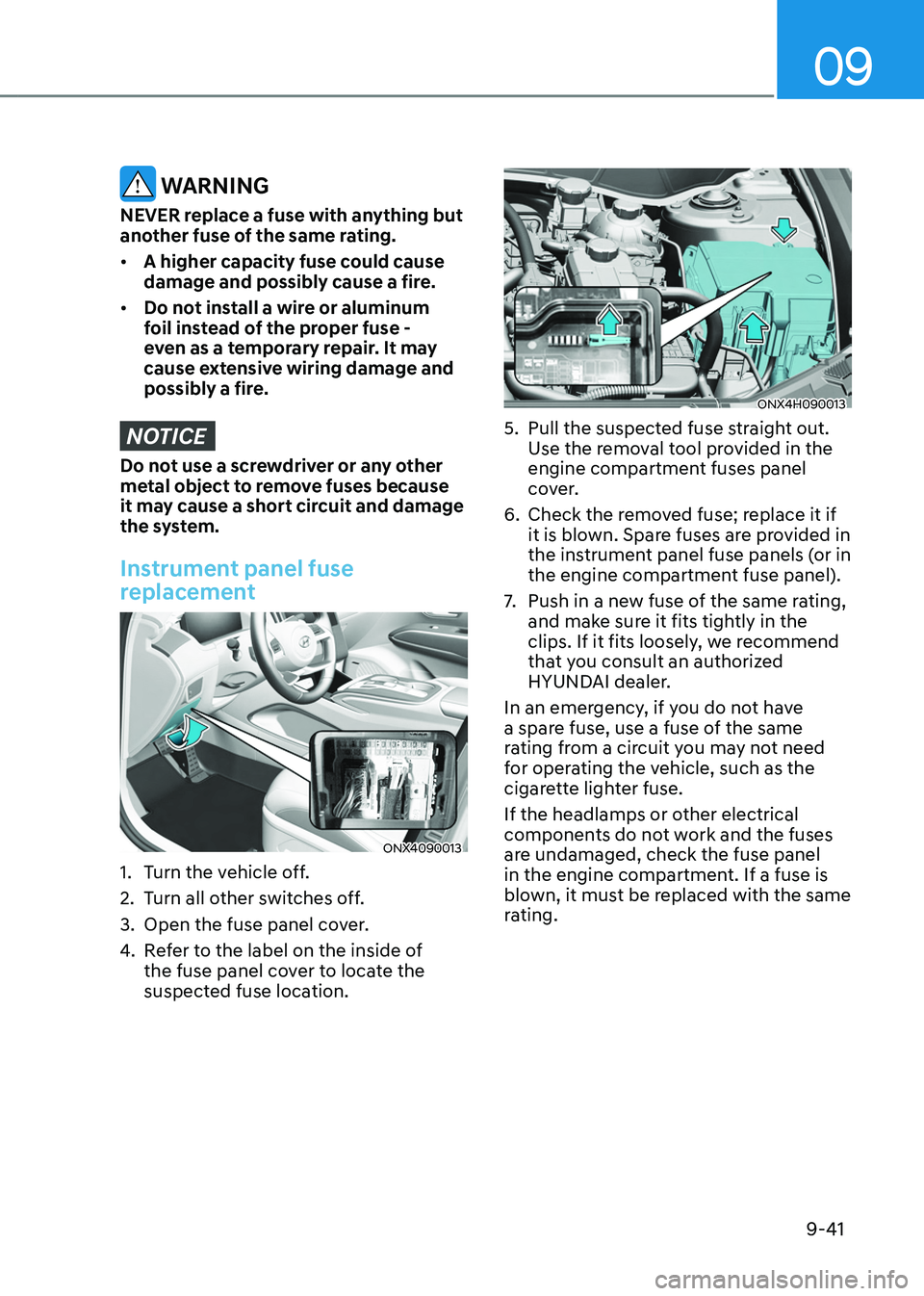
09
9-41
WARNING
NEVER replace a fuse with anything but
another fuse of the same rating.
• A higher capacity fuse could cause
damage and possibly cause a fire.
• Do not install a wire or aluminum
foil instead of the proper fuse -
even as a temporary repair. It may
cause extensive wiring damage and
possibly a fire.
NOTICE
Do not use a screwdriver or any other
metal object to remove fuses because
it may cause a short circuit and damage
the system.
Instrument panel fuse
replacement
ONX4090013
1. Turn the vehicle off.
2.
Turn all o
ther switches off.
3.
Open the fuse panel cov
er.
4.
Re
fer to the label on the inside of
the fuse panel cover to locate the
suspected fuse location.
ONX4H090013
5. Pull the suspected fuse s traight out.
Use the removal tool provided in the
engine compartment fuses panel
cover.
6.
Check the remo
ved fuse; replace it if
it is blown. Spare fuses are provided in
the instrument panel fuse panels (or in
the engine compartment fuse panel).
7.
Push in a new fuse o
f the same rating,
and make sure it fits tightly in the
clips. If it fits loosely, we recommend
that you consult an authorized
HYUNDAI dealer.
In an emergency, if you do not have
a spare fuse, use a fuse of the same
rating from a circuit you may not need
for operating the vehicle, such as the
cigarette lighter fuse.
If the headlamps or other electrical
components do not work and the fuses
are undamaged, check the fuse panel
in the engine compartment. If a fuse is
blown, it must be replaced with the same
rating.
Page 598 of 630
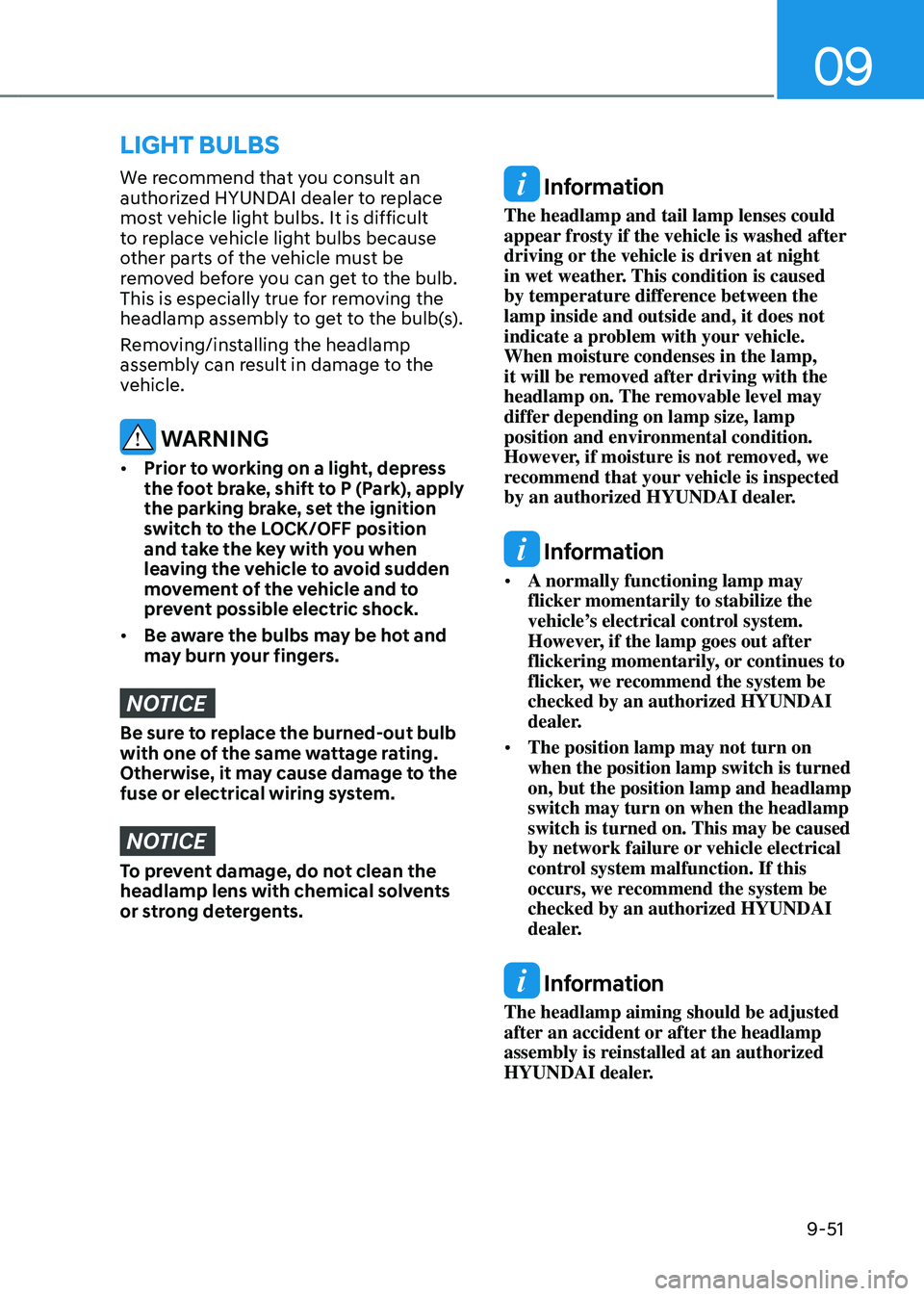
09
9-51
We recommend that you consult an
authorized HYUNDAI dealer to replace
most vehicle light bulbs. It is difficult
to replace vehicle light bulbs because
other parts of the vehicle must be
removed before you can get to the bulb.
This is especially true for removing the
headlamp assembly to get to the bulb(s).
Removing/installing the headlamp
assembly can result in damage to the
vehicle.
WARNING
• Prior to working on a light, depress
the foot brake, shift to P (Park), apply
the parking brake, set the ignition
switch to the LOCK/OFF position
and take the key with you when
leaving the vehicle to avoid sudden
movement of the vehicle and to
prevent possible electric shock.
• Be aware the bulbs may be hot and
may burn your fingers.
NOTICE
Be sure to replace the burned-out bulb
with one of the same wattage rating.
Otherwise, it may cause damage to the
fuse or electrical wiring system.
NOTICE
To prevent damage, do not clean the
headlamp lens with chemical solvents
or strong detergents.
Information
The headlamp and tail lamp lenses could
appear frosty if the vehicle is washed after
driving or the vehicle is driven at night
in wet weather. This condition is caused
by temperature difference between the
lamp inside and outside and, it does not
indicate a problem with your vehicle.
When moisture condenses in the lamp,
it will be removed after driving with the
headlamp on. The removable level may
differ depending on lamp size, lamp
position and environmental condition.
However, if moisture is not removed, we
recommend that your vehicle is inspected
by an authorized HYUNDAI dealer.
Information
• A normally functioning lamp may
flicker momentarily to stabilize the
vehicle’s electrical control system.
However, if the lamp goes out after
flickering momentarily, or continues to
flicker, we recommend the system be
checked by an authorized HYUNDAI
dealer.
• The position lamp may not turn on
when the position lamp switch is turned
on, but the position lamp and headlamp
switch may turn on when the headlamp
switch is turned on. This may be caused
by network failure or vehicle electrical
control system malfunction. If this
occurs, we recommend the system be
checked by an authorized HYUNDAI
dealer.
Information
The headlamp aiming should be adjusted
after an accident or after the headlamp
assembly is reinstalled at an authorized
HYUNDAI dealer.
light bulbs
Page 606 of 630
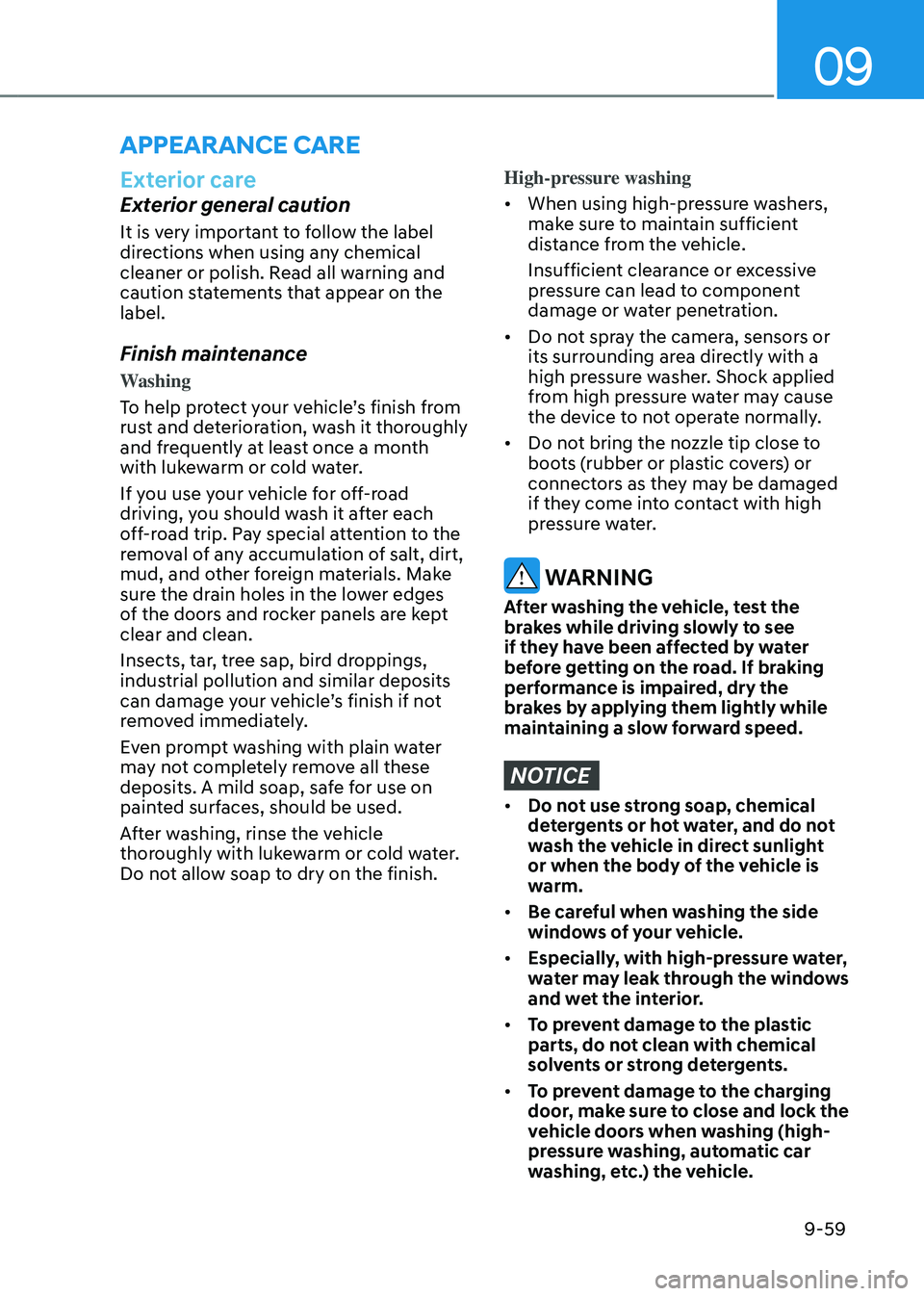
09
9-59
appEarancE carE
Exterior care
Exterior general caution
It is very important to follow the label
directions when using any chemical
cleaner or polish. Read all warning and
caution statements that appear on the
label.
Finish maintenance
Washing
To help protect your vehicle’s finish from
rust and deterioration, wash it thoroughly
and frequently at least once a month
with lukewarm or cold water.
If you use your vehicle for off-road
driving, you should wash it after each
off-road trip. Pay special attention to the
removal of any accumulation of salt, dirt,
mud, and other foreign materials. Make
sure the drain holes in the lower edges
of the doors and rocker panels are kept
clear and clean.
Insects, tar, tree sap, bird droppings,
industrial pollution and similar deposits
can damage your vehicle’s finish if not
removed immediately.
Even prompt washing with plain water
may not completely remove all these
deposits. A mild soap, safe for use on
painted surfaces, should be used.
After washing, rinse the vehicle
thoroughly with lukewarm or cold water.
Do not allow soap to dry on the finish.
High-pressure washing
• When using high-pressure washers,
make sure to maintain sufficient
distance from the vehicle.
Insufficient clearance or excessive
pressure can lead to component
damage or water penetration.
• Do not spray the camera, sensors or
its surrounding area directly with a
high pressure washer. Shock applied
from high pressure water may cause
the device to not operate normally.
• Do not bring the nozzle tip close to
boots (rubber or plastic covers) or
connectors as they may be damaged
if they come into contact with high
pressure water.
WARNING
After washing the vehicle, test the
brakes while driving slowly to see
if they have been affected by water
before getting on the road. If braking
performance is impaired, dry the
brakes by applying them lightly while
maintaining a slow forward speed.
NOTICE
• Do not use strong soap, chemical
detergents or hot water, and do not
wash the vehicle in direct sunlight
or when the body of the vehicle is
warm.
• Be careful when washing the side
windows of your vehicle.
• Especially, with high-pressure water,
water may leak through the windows
and wet the interior.
• To prevent damage to the plastic
parts, do not clean with chemical
solvents or strong detergents.
• To prevent damage to the charging
door, make sure to close and lock the
vehicle doors when washing (high-
pressure washing, automatic car
washing, etc.) the vehicle.
Page 608 of 630
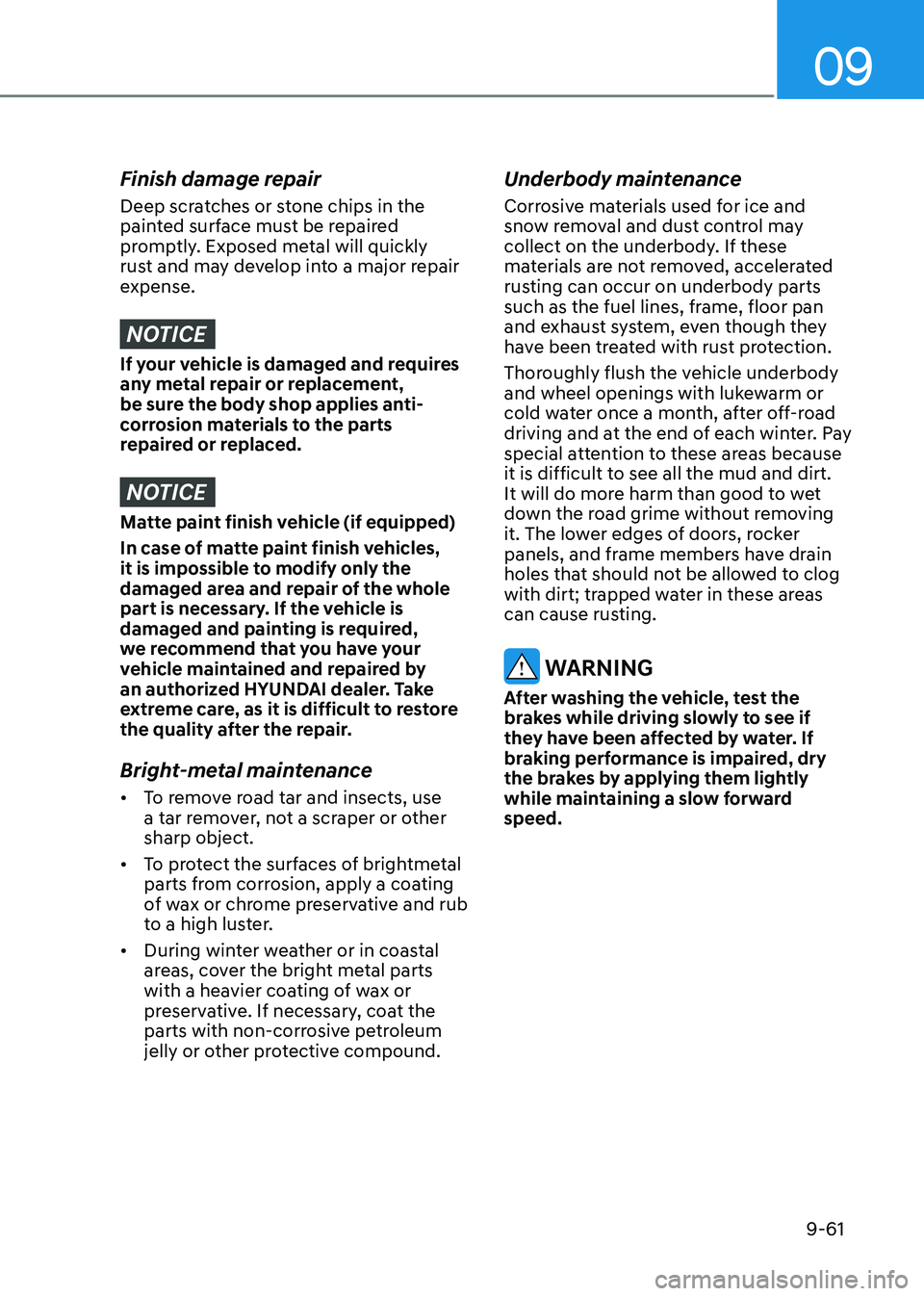
09
9-61
Finish damage repair
Deep scratches or stone chips in the
painted surface must be repaired
promptly. Exposed metal will quickly
rust and may develop into a major repair
expense.
NOTICE
If your vehicle is damaged and requires
any metal repair or replacement,
be sure the body shop applies anti-
corrosion materials to the parts
repaired or replaced.
NOTICE
Matte paint finish vehicle (if equipped)
In case of matte paint finish vehicles,
it is impossible to modify only the
damaged area and repair of the whole
part is necessary. If the vehicle is
damaged and painting is required,
we recommend that you have your
vehicle maintained and repaired by
an authorized HYUNDAI dealer. Take
extreme care, as it is difficult to restore
the quality after the repair.
Bright-metal maintenance
• To remove road tar and insects, use
a tar remover, not a scraper or other
sharp object.
• To protect the surfaces of brightmetal
parts from corrosion, apply a coating
of wax or chrome preservative and rub
to a high luster.
• During winter weather or in coastal
areas, cover the bright metal parts
with a heavier coating of wax or
preservative. If necessary, coat the
parts with non-corrosive petroleum
jelly or other protective compound.
Underbody maintenance
Corrosive materials used for ice and
snow removal and dust control may
collect on the underbody. If these
materials are not removed, accelerated
rusting can occur on underbody parts
such as the fuel lines, frame, floor pan
and exhaust system, even though they
have been treated with rust protection.
Thoroughly flush the vehicle underbody
and wheel openings with lukewarm or
cold water once a month, after off-road
driving and at the end of each winter. Pay
special attention to these areas because
it is difficult to see all the mud and dirt.
It will do more harm than good to wet
down the road grime without removing
it. The lower edges of doors, rocker
panels, and frame members have drain
holes that should not be allowed to clog
with dirt; trapped water in these areas
can cause rusting.
WARNING
After washing the vehicle, test the
brakes while driving slowly to see if
they have been affected by water. If
braking performance is impaired, dry
the brakes by applying them lightly
while maintaining a slow forward
speed.
Page 625 of 630

Index
I-8
Instrument cluster ........................................................................\
..........................4-4
Instrument cluster control ........................................................................\
...........4-5
Gauges and meters ........................................................................\
.....................4-5
Transmission shift indicator ........................................................................\
.......4-9
Warning and indicator lights ........................................................................\
....4-10
LCD display messages ........................................................................\
.............4-22
Instrument panel overview (I)
........................................................................\
......2-5
Instrument panel overview (II)
........................................................................\
.....2-6
Integrated memory system
........................................................................\
...........5-38
Recalling memory positions ........................................................................\
.....5-39
Resetting the system ........................................................................\
.................5-39
Seat Easy Access Operation ........................................................................\
.....5-40
Storing memory positions ........................................................................\
........5-38
Intelligent Speed Limit Assist (ISLA)
.................................................................7-52
System malfunction and limitations .................................................................7-55
System operation ........................................................................\
......................7-53
System settings ........................................................................\
.........................7-52
Interior features
........................................................................\
..........................5-117
Cargo security screen ........................................................................\
.............5-125
Clock ........................................................................\
......................................5-123
Coat hook ........................................................................\
...............................5-123
Cup holder ........................................................................\
..............................5-117
Floor mat anchor(s) ........................................................................\
................5-124
Luggage net holder ........................................................................\
.................5-124
Power outlet ........................................................................\
............................5-118
Sunvisor ........................................................................\
..................................5-118
USB charger ........................................................................\
...........................5-119
Wireless smart phone charging system ..........................................................5-120
Interior lights
........................................................................\
...............................5-88
Front lamps ........................................................................\
...............................5-88
Glove box lamp ........................................................................\
........................5-90
Interior Lamp AUT O OFF ........................................................................\
.......5-88
Luggage compartment lamp ........................................................................\
.....5-90
Rear lamps ........................................................................\
................................5-89
Vanity mirror lamp ........................................................................\
...................5-89
Welcome system ........................................................................\
.......................5-91
Interior overview
........................................................................\
..........................2-4
Page 628 of 630
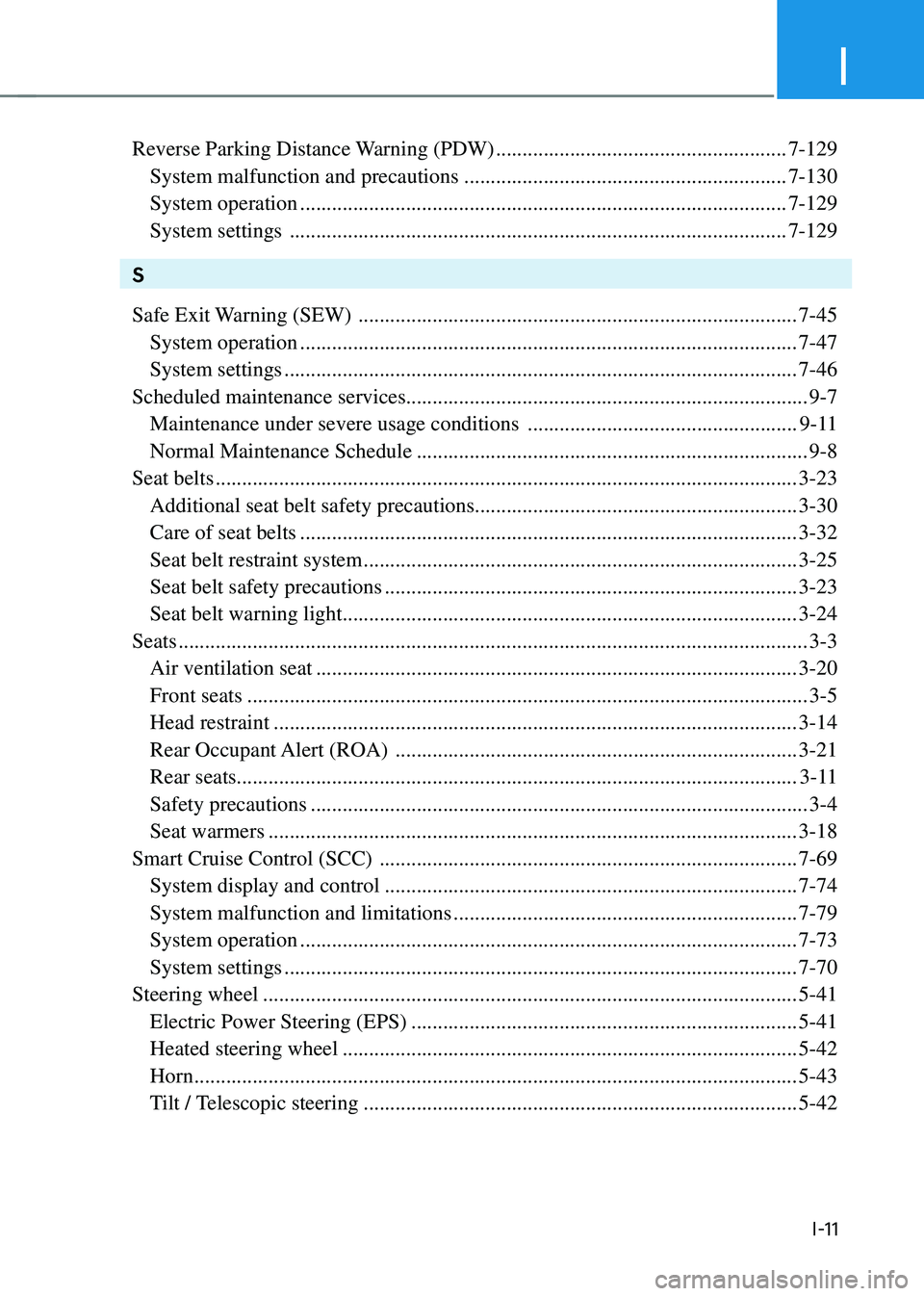
I
I-11
Reverse Parking Distance Warning (PDW) .......................................................7-129
System malfunction and precautions .............................................................7-130
System operation ........................................................................\
....................7-129
System settings ........................................................................\
......................7-129
S
Safe Exit Warning (SEW)
........................................................................\
...........7-45
System operation ........................................................................\
......................7-47
System settings ........................................................................\
.........................7-46
Scheduled maintenance services ........................................................................\
.... 9-7
Maintenance under severe usage conditions ...................................................9-11
Normal Maintenance Schedule ........................................................................\
..9-8
Seat belts
........................................................................\
......................................3-23
Additional seat belt safety precautions .............................................................3-30
Care of seat belts ........................................................................\
......................3-32
Seat belt restraint system ........................................................................\
..........3-25
Seat belt safety precautions ........................................................................\
......3-23
Seat belt warning light ........................................................................\
..............3-24
Seats
........................................................................\
...............................................3-3
Air ventilation seat ........................................................................\
...................3-20
Front seats ........................................................................\
..................................3-5
Head restraint ........................................................................\
...........................3-14
Rear Occupant Alert (ROA) ........................................................................\
....3-21
Rear seats ........................................................................\
..................................3-11
Safety precautions ........................................................................\
......................3-4
Seat warmers ........................................................................\
............................3-18
Smart Cruise Control (SCC)
........................................................................\
.......7-69
System display and control ........................................................................\
......7-74
System malfunction and limitations .................................................................7-79
System operation ........................................................................\
......................7-73
System settings ........................................................................\
.........................7-70
Steering wheel
........................................................................\
.............................5-41
Electric Power Steering (EPS) ........................................................................\
.5-41
Heated steering wheel ........................................................................\
..............5-42
Horn ........................................................................\
..........................................5-43
Tilt / Telescopic steering ........................................................................\
..........5-42
Page 629 of 630
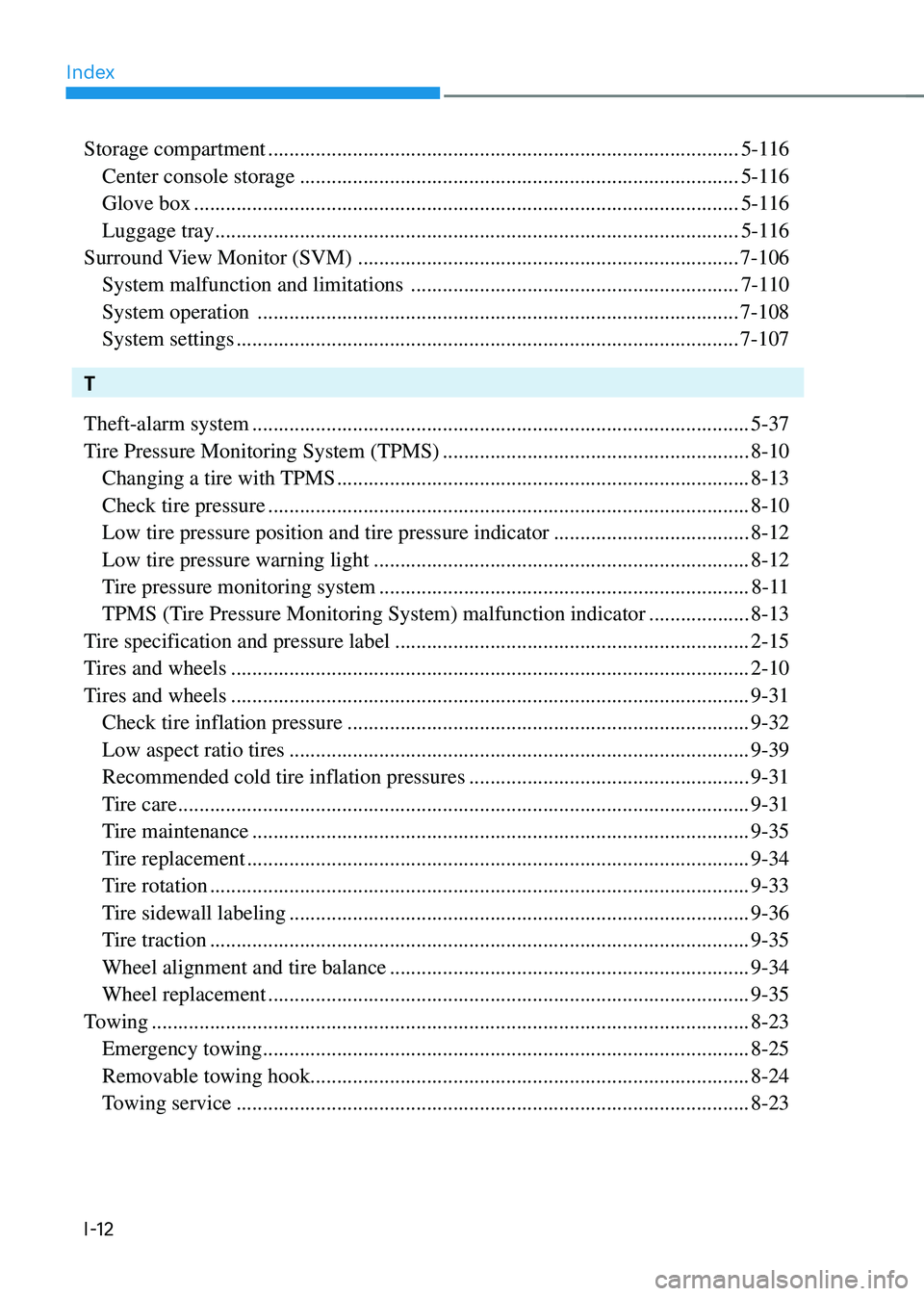
Index
I-12
Storage compartment ........................................................................\
.................5-116
Center console storage ........................................................................\
...........5-116
Glove box ........................................................................\
...............................5-116
Luggage tray ........................................................................\
...........................5-116
Surround View Monitor (SVM)
........................................................................\
7-106
System malfunction and limitations ..............................................................7-110
System operation ........................................................................\
...................7-108
System settings ........................................................................\
.......................7-107
T
Theft-alarm system
........................................................................\
......................5-37
Tire Pressure Monitoring System (TPMS)
..........................................................8-10
Changing a tire with TPMS ........................................................................\
......8-13
Check tire pressure ........................................................................\
...................8-10
Low tire pressure position and tire pressure indicator .....................................8-12
Low tire pressure warning light .......................................................................8-12
Tire pressure monitoring system ......................................................................8-11
TPMS (Tire Pressure Monitoring System) malfunction indicator ...................8-13
Tire specification and pressure label
...................................................................2-15
Tires and wheels
........................................................................\
..........................2-10
Tires and wheels
........................................................................\
..........................9-31
Check tire inflation pressure ........................................................................\
....9-32
Low aspect ratio tires ........................................................................\
...............9-39
Recommended cold tire inflation pressures .....................................................9-31
Tire care ........................................................................\
....................................9-31
Tire maintenance ........................................................................\
......................9-35
Tire replacement ........................................................................\
.......................9-34
Tire rotation ........................................................................\
..............................9-33
Tire sidewall labeling ........................................................................\
...............9-36
Tire traction ........................................................................\
..............................9-35
Wheel alignment and tire balance ....................................................................9-34
Wheel replacement ........................................................................\
...................9-35
Towing
........................................................................\
.........................................8-23
Emergency towing ........................................................................\
....................8-25
Removable towing hook ........................................................................\
...........8-24
Towing service ........................................................................\
.........................8-23